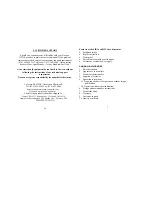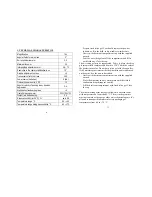
3. TECHNICAL CHARACTERISTICS
Magnification 16x
Angular field of view, no less
3°
Exit pupil diameter, mm
2.5
Minimum focus, m
30
Interpupillary adjustment, mm:
58 – 72
Resolution in the center, stabilization is on
10”
Dioptric adjustment, no less
±
5
Transmission factor, not less
0.55
Power source (batteries)
6 (AA)
On-board power source, V DC
12
Angular velocity of panning in any direction,
degree/sec:
0 - 6
Stabilization freedom, degrees
±
5
Overall dimensions, mm:
230×190×120
Weight (w/o batteries), kg,
2.4
Relative humidity (at +25°C) %:
up to 98
Temperature range, °C
-25
÷
+45
Temperature range during transportation,
o
C
-40
÷
+70
6
-
Prepare fresh silica gel. You should replace the powder
indoors or, if in the field, in dry windless weather only.
-
Unscrew the desiccant compartment cap with the supplied
wrench.
-
Pour the wet silica gel out off the compartment and fill it
with fresh one. Close the cap.
The wet silica gel may be regenerated. To dry it, place the silica
gel into metallic container and heat it to 120 °C until the color of
the powder turns blue. Do not burn silica gel with the open fire.
If the moisture penetrates inside the binocular and is condensed
on the optics, dry the unit as described:
-
Unscrew the desiccant compartment cap with the supplied
wrench.
-
Place the binocular in a dry warm place until the visible
condensate drops disappear entirely.
-
Fill the desiccant compartment with fresh silica gel. Close
the cap.
The binocular long-term storage is allowed in a heated room
with temperature no lower than 5 °C. The air in the premises
must not contain acid vapor or other active chemical agents. It’s
allowed to transport binoculars in factory packaging at
temperatures from -40 to +70 °C.
11


















